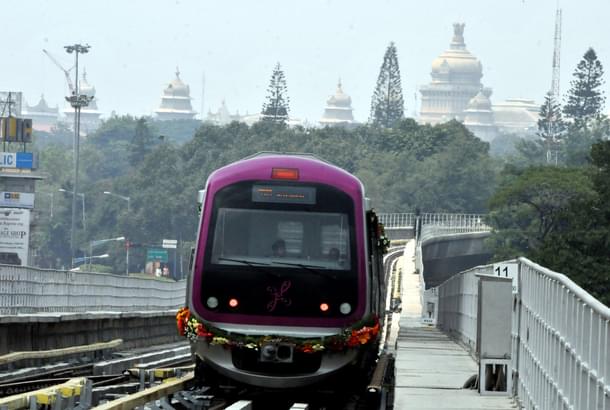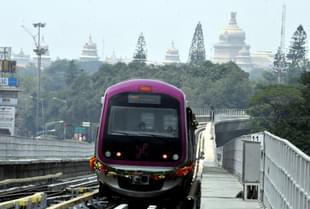Infrastructure
Bengaluru Could Boast Of Nearly 400 km Of Metro, Suburban Rail Network By 2030 As Union Govt Approves Namma Metro Phase 3
Swarajya Staff
Aug 17, 2024, 11:48 AM | Updated Aug 19, 2024, 07:45 AM IST
Save & read from anywhere!
Bookmark stories for easy access on any device or the Swarajya app.


The Union Cabinet, chaired by Prime Minister Narendra Modi, approved Phase 3 of the Bengaluru Metro Rail Project on Friday.
Phase 3 of Namma Metro will be built at an estimated cost of Rs.15,611 crore. Besides 20% equity participation by Union and State governments, Bangalore Metro Rail Corporation Limited (BMRCL) is likely to secure a loan of over Rs 7000 crore from the Japan International Cooperation Agency (JICA).
Once the Phase-3 of Namma Metro is operationalised, Bengaluru will have 220.20 Km of active metro rail network.
The BMRCL has also prepared the Detailed Project Report (DPR) for the 36.59 km Phase 3A (Red Line). DPR is awaiting state government approval.
Phase 3A is envisaged as a combination of underground and elevated lines that would run from Sarjapur to Hebbal. 28 stations are planned under this phase. The line will pass through the city's center, connecting Carmeleram, Agara, Koramangala, Dairy Circle, Central College, and Armane Nagar.
Besides the extensive metro rail network, the Karnataka Rail Infrastructure Development Company Limited (K-RIDE) is implementing the Bengaluru Suburban Rail Project (BSRP). Over 147 km of rail network across four corridors is also under construction as part of this project. The project is expected to be complete by the end of 2030.
If the proposed metro and suburban rail networks are completed by 2030, India's technology powerhouse could have close to 400 km of rail-based public transport.
.png?w=610&q=75&compress=true&format=auto)
About Namma Metro Phase 3
The Phase 3 (Orange Line) will comprise of two elevated corridors of 44.65 Km and feature 31 stations.
Corridor-1 from JP Nagar 4thPhase to Kempapura with 22 stations
Corridor-2 from Hosahalli to Kadabagere (along Magadi Road) for a length of 12.50 Km with nine stations.

The station in phase 3 have been proposed at Kempapura, Hebbal, Nagashetty Halli, BEL Circle, Muthyalanagar, Peenya, Kanteerava Nagar, Freedom Fighter’s Colony, Chowdeshwari Nagar, Sumanahalli Cross, BDA Complex Nagarbhavi, Papireddy Palya, Vinayaka Layout, Nagarbhavi Circle, Mysuru Road, Dwaraka Nagar, Hosakerehalli, Kamakya Junction, Kadirenahalli, JP Nagar, JP Nagar 5th Phase and JP Nagar 4th Phase
Multi-Modal Integration& Last Mile Connectivity:
Multi-Modal Integration is planned at 10 locations at JP Nagar 4th Phase, JP Nagar, Kamakya, Mysore Road, Sumanahalli, Peenya, BEL Circle, Hebbal, Kempapura, Hosahalli and provides interchanges with existing and under construction Metro Stations, BMTC Bus stands, Indian Railway Stations, proposed Suburban (K-RIDE) Stations.
All the Phase-3 stations are proposed with dedicated bus bays, Pick up and drop off bays, Pedestrian Paths, IPT/Auto Rickshaw stands. BMTC is already running feeder buses to the operational metro stations and the same will be extended to the Phase-3 stations also. Parking facilities have been provided at 11 important stations.
The existing stations of Phase-1 & Phase-2 are integrated with proposed stations of Phase-3.Direct connectivity through FoBs/Skywalks to two Railway stations (Lottegollahali and Hebbal). At Phase-3 metro stations, provision for bikes and cycles sharing facility will also be provided.
Phase-3 will integrate key areas of the city which includes Peenya Industrial Area, IT industries on Bannerghatta road and Outer Ring Road, Textile and Engineering items Manufacturing units on Tumkuru Road and ORR, Bharat Electronics Limited (BEL), Major educational institutions like PES University, Ambedkar College, Polytechnic College, KLE College, Dayanandsagar University, ITI etc.
Phase-3 corridors also provide connectivity to the Southern part of the city, Outer Ring Road West, Magadi road and various neighbourhoods, enhancing overall connectivity in the city. Improved last mile connectivity to commercial centres, industrial hubs, educational institutions, and healthcare facilities will facilitate better access for residents.





